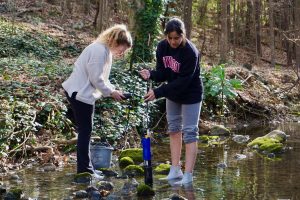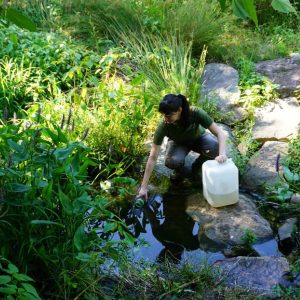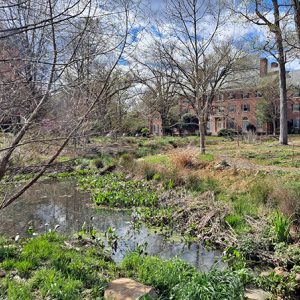Water
Careful Monitoring and Strategically Planned Infrastructure
UNC-Chapel Hill is located in the Jordan Lake Watershed. Knowing our campus streams ultimately drain into a water source for more than 700,000 North Carolinians, Sustainable Carolina pays special attention to stormwater management and water quality monitoring.
Across campus, UNC-Chapel Hill plants low-maintenance landscapes capable of retaining water. Inside buildings, the University focuses on incorporating water saving measures, like eliminating leaks and increasing non-potable water use.

Water Dashboard
In 2021, our water conservation and reclamation efforts saved more than 350 million gallons of water. A key point of the University’s Water Plan is decreasing potable water, also known as drinking water, use. Water doesn’t need to be drinking-water quality for things like toilet flushing and irrigation.
Through innovative water management and conservation practices, the University decreased its potable water consumption by 43%. Potable water consumption decreased an average of 229 million gallon every year for the past 5 years.
The availability of non-potable water on campus has been a game-changer for our conservation efforts.
UNC-Chapel Hill Water Plan
UNC-Chapel Hill’s Water Plan outlines three main strategies and several sub-strategies for achieving two goals:
- Reduce our water footprint by using more non-potable water and decreasing stormwater runoff.
- Create a network of water-related research and researchers to amplify significant work.
The plan is a living document and is updated as progress is made.
Water Plan
Water History
 In the 2000s, North Carolina experienced two record-breaking droughts. After the first in 2001-02, Orange County Water and Sewer Authority (OWASA) and UNC-Chapel Hill performed a feasibility study for a reclaimed water system. Reclaimed water is highly treated water that can take the use of potable water for things like irrigation, toilet flushing and more.
In the 2000s, North Carolina experienced two record-breaking droughts. After the first in 2001-02, Orange County Water and Sewer Authority (OWASA) and UNC-Chapel Hill performed a feasibility study for a reclaimed water system. Reclaimed water is highly treated water that can take the use of potable water for things like irrigation, toilet flushing and more.
The reclaimed water pipeline was built in 2008 on campus, and millions of gallons of water began traveling from the wastewater treatment plant to campus for athletic field irrigation.
This project kickstarted our partnership with OWASA, which continues to this day. In 2004, cisterns, or concrete vaults that store water underground, were installed near the Genome Sciences Building. The vaults hold up to 360,000 gallons of stormwater. This stormwater is used for Kenan Stadium and toilet flushing in the Genome Sciences Building.
Visit our ESRI story map to learn more about campus water history.
Water Stories
Campus Partners
UNC Water Institute: Provides real-world solutions to the most pressing water and sanitation challenges. The group specializes in technical innovation, professional development and entrepreneurship for policy-leaders, practitioners and researchers.
Environmental Finance Center: Housed in the UNC School of Government, the EFC connects with local communities and state and federal programs on a variety of topics, including stormwater and water utilities.
UNC Environment, Health and Safety Stormwater Program: Engages in education and outreach, pollution prevention, stormwater control projects and more. The University operates its own stormwater system under the National Pollutant Discharge Elimination System (NPDES) permitting program.





